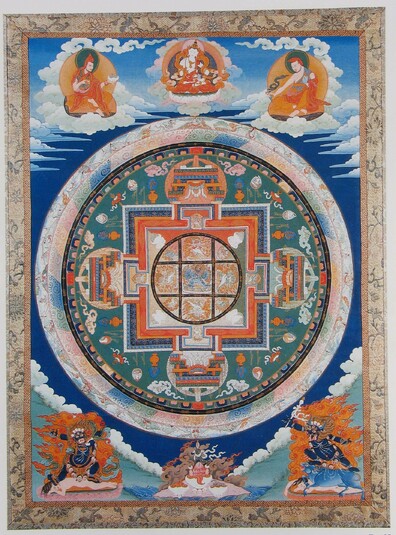
Item: Mandala of Vajrabhairava (Buddhist Deity) - with consort
| Origin Location | Tibet |
|---|---|
| Date Range | 1800 - 1899 |
| Lineages | Gelug and Buddhist |
| Material | Ground Mineral Pigment on Cotton |
| Collection | Publication: A Tale of Thangkas |
Classification: Deity
Appearance: Animal-Feature
Gender: Male
Vajrabhairava Mandala according to the Shri Vajrabhairava Nama Tantra [Toh 468]. This painting is likely from a set of paintings depicting the principal meditational deities of the Gelug Tradition.

Vajrabhairava is a wrathful form of Manjushri and functions as a meditational deity of the Anuttarayoga Classification in Tantric Buddhism. Vajrabhairava is NOT a protector deity and is NOT included in any Buddhist classifications of protectors. As a principal meditational deity Vajrabhairava, belongs to the Vajrabhairava and Yamari class of tantras and specifically arises from the Vajrabhairava Root Tantra (Tib.: jig je tsa gyu). The Vajrabhairava and Yamari Tantras belong to the method (father) classification of Anuttaryoga Tantra.
The practice of Vajrabhairava is common to the three main Sarma Schools of Tibetan Buddhism: Sakya, Kagyu and Gelug. Among the Sakya it is counted as one of the four main tantric deities along with Hevajra, Guhyasamaja and Chakrasamvara (Tib.: gyu de shi). Amongst the various Kagyu Schools the Drigungpa are strong upholders of the practice. In the Gelug School Vajrabhairava is the principal meditational deity taught for Anuttarayoga practice along with the meditational deities Akshobhyavajra Guhyasamaja and Chakrasamvara. There are numerous forms and styles of practice from the very complex with numerous deities to the very concise with a single Heruka form - one face and two arms. From amongst the many different lineages and teachings of Vajrabhairava to enter Tibet it is said that the main ones were those of Rwa Lotsawa and Mal Lotsawa.
Jeff Watt 2-2010 [image added 2-2014]
Tradition: Gelug Mandala Masterworks
Buddhist Deity: Vajrabhairava Main Page
Publication: A Tale of Thangkas
Buddhist Deity: Vajrabhairava Thirteen Deity Configuration
Buddhist Deity: Vajrabhairava (Mandala Masterworks)
Buddhist Deity: Vajrabhairava Religious Context
